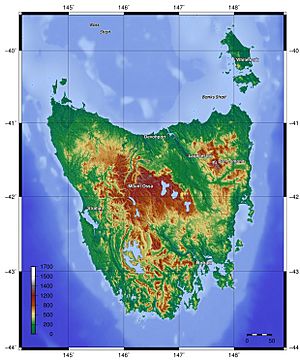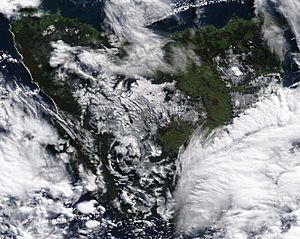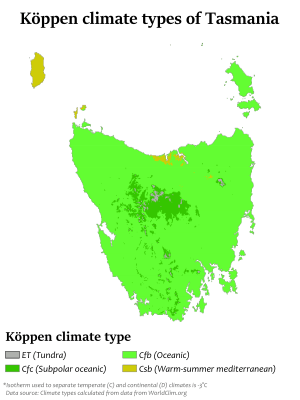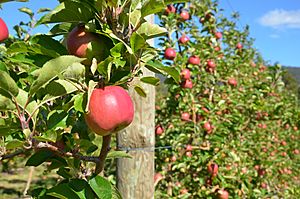Geography of Tasmania facts for kids
Tasmania is a large island state of Australia. It covers about 68,401 square kilometers (26,410 square miles). It sits in the path of strong winds called the "Roaring Forties". To its north, the Bass Strait separates it from mainland Australia. Tasmania is the only Australian state not on the mainland. About 2,500 kilometers (1,350 nautical miles) south of Tasmania is the George V Coast of Antarctica.
Depending on how ocean borders are defined, Tasmania is either surrounded by the Southern Ocean or has the Pacific Ocean to its east and the Indian Ocean to its west. Other definitions place the Great Australian Bight to its west and the Tasman Sea to its east. The southernmost point on mainland Tasmania is South East Cape. The northernmost point is in Woolnorth / Temdudheker near Cape Grim / Kennaook. Tasmania is at similar latitudes to the Te Waipounamu / South Island of New Zealand and parts of Patagonia in South America. In the Northern Hemisphere, it's like Hokkaido in Japan, Northeast China (Manchuria), the northern Mediterranean in Europe, and the Canada-United States border.

The Central Highlands is the most mountainous area. It covers much of the central western part of the state. The Midlands, in the central east, is quite flat. It is mainly used for farming, though farms are found all over the state. Mount Ossa is Tasmania's tallest mountain, standing 1,617 meters (5,305 feet) high.
Much of Tasmania is still covered in thick forests. The Southwest National Park and nearby areas have some of the last temperate rainforests in the Southern Hemisphere. The Tarkine region, in the far north-west, is Australia's largest temperate rainforest. It covers about 3,800 square kilometers (1,500 square miles). Tasmania has many rivers due to its rugged land. Several large rivers have been dammed to create hydroelectricity. Many rivers start in the Central Highlands and flow to the coast. Most of Tasmania's main towns are located around estuaries (where rivers meet the sea).
Tasmania's main island looks like a triangle pointing downwards. People compare it to a shield, a heart, or a face. The state includes the main island and at least a thousand smaller islands. The largest of these are Flinders Island and Cape Barren Island in the Furneaux Group (Bass Strait), King Island (west Bass Strait), Bruny Island (separated by the D'Entrecasteaux Channel), Macquarie Island (1,500 km from Tasmania), and Maria Island (off the east coast).
Tasmania has many separate and connected mountain ranges. Much of the state has a lot of dolerite rock. The western half is older and more rugged. It has buttongrass plains, temperate rainforests, and quartzite ranges like Federation Peak and Frenchmans Cap. These mountains cause a "rain shadow effect". This means the western half gets most of the rain, which affects the types of plants that grow there. The Central Highlands has a large plateau with many ranges and steep slopes on its north side. It gets lower towards the south and spreads into the highest mountains in the west. To the north-west of this, another plateau spreads into hills where the takayna / Tarkine is found.
The Interim Biogeographic Regionalisation for Australia (IBRA) divides Tasmania into 9 natural regions:
- Ben Lomond
- Furneaux
- King
- Central Highlands
- Northern Midlands
- Northern Slopes
- Southern Ranges
- South East
- West
Contents
Tasmania's Natural Environment
Tasmania's environment has many different natural areas. It is the most forested state in Australia. It protects the country's largest areas of temperate rainforest. A special type of moorland called buttongrass plains is found in western and south-western Tasmania. It is thought that Tasmanian Aboriginal people expanded these plains by using fire to manage the land. Tasmania also has diverse alpine plant areas, including cushion plants.
Highland areas usually get snow above 1,000 meters (3,300 feet) every year. Because of cold air from Antarctica, snow often falls at 800 meters (2,600 feet), and sometimes even at 600 or 400 meters (2,000 or 1,300 feet). About every five years, snow can even fall at sea level. This cold environment helps cypress forests grow in the Central Plateau and other mountainous areas. For example, the Walls of Jerusalem has large areas of rare pencil pine and its close relative, King Billy pine. On the West Coast Range and parts of Mount Field, you can find Australia's only winter-deciduous plant, the deciduous beech. It grows as a low, dense shrub or rarely as a 4-meter (13-foot) tree.
Tasmania has many waterfalls. They can be found in small creeks, alpine streams, fast-flowing rivers, or falling from high cliffs. Some of the tallest waterfalls are on mountain massifs, sometimes dropping 200 meters (660 feet). The most famous waterfall is Russell Falls in Mount Field. It's popular because it's close to Hobart and has beautiful stepped falls, reaching a total height of 58 meters (190 feet).
Tasmania also has many beaches. The longest is Ocean Beach on the West Coast, which is about 40 kilometers (25 miles) long. Wineglass Bay in Freycinet on the east coast is a famous landmark of the state.
The Tasmanian temperate rainforests come in a few different types. These are different from the more common wet sclerophyll forests, which have eucalypt trees. However, these eucalypt forests often have rainforest plants and ferns (like tree-ferns) growing underneath. Rainforests in deep gullies can be hard to walk through because of dense undergrowth, such as the "horizontal" plant (Anodopetalum biglandulosum). Forests at higher elevations (around 500 to 800 meters or 1,600 to 2,600 feet) have smaller plants on the ground, making them easier to explore. Most common rainforests have a tree top layer (canopy) about 50 meters (160 feet) high. Very tall eucalyptus trees can grow even higher, sometimes another 50 meters (160 feet) above the canopy. These tall trees are often used as nesting spots for giant wedge-tailed eagles.
Human activity in Tasmania ranges from cities and industrial areas to farming and grazing land. The most farmed area is the Midlands. It has good soil and is also the driest part of the state.
How Tasmania Became an Island
Captain Abel Tasman may have noticed Tasmania was an island when he mapped its coast in 1642. On December 5, Tasman was sailing north along the east coast to see how far it went. When the land turned north-west at Eddystone Point, he tried to follow it. But his ships were suddenly hit by the strong Roaring Forties winds blowing through Bass Strait. Tasman was looking for a large southern continent, not more islands. So, he quickly turned east and kept searching for the continent.
The next European to enter the strait was Captain James Cook on HMS Endeavour in April 1770. After sailing for two hours westward into the strait against the wind, he turned back east. He wrote in his journal that he was "doubtful whether they [Van Diemen's Land and New Holland] are one land or no."
The strait was named after George Bass. He and Matthew Flinders sailed through it while going around Van Diemen's Land in the Norfolk in 1798–99. Flinders suggested the name, and in 1800, Governor John Hunter of New South Wales named the water between the mainland and Van Diemen's Land "Bass's Straits." Later, it became known as Bass Strait.
The idea that a strait existed was first suggested in 1797. The master of the ship Sydney Cove reached Sydney after his ship ran aground on Preservation Island (at the eastern end of the strait). He reported that the strong south-westerly swell, tides, and currents suggested the island was in a channel connecting the Pacific and southern Indian Oceans. Because of this, Governor Hunter wrote to Joseph Banks in August 1797 that it seemed certain a strait existed.
Tasmania's Climate
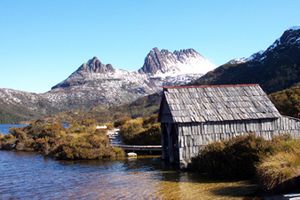
Tasmania has a cool, mild climate compared to the rest of Australia. It avoids the very hot summers of the mainland and has four clear seasons. Summer is from December to February. The average highest sea temperature is 21°C (70°F). Inland areas around Launceston reach about 24°C (75°F). Other inland areas are much cooler. Liawenee, on the Central Plateau, is one of Australia's coldest places. Its temperatures range between 4°C (39°F) and 17°C (63°F) in February.
Autumn is from March to May. The weather is usually calm as summer patterns slowly change to winter patterns. The winter months are from June to August. These are generally the wettest and coldest months. Most high areas get a lot of snow. Winter high temperatures average 12°C (54°F) along coastal areas and 3°C (37°F) on the central plateau. This is due to cold fronts from the Southern Ocean. Inland areas often have freezing temperatures throughout winter.
Spring is from September to November. It is a changing season where winter weather patterns start to become like summer. However, snow is still common until October. Spring is generally the windiest time of year. Afternoon sea breezes start to affect the coast.
Tasmania's Soil
Even though Tasmania had some ice ages, its soils are not more fertile than mainland Australia's. This is mostly because many soils are very leached (washed out of nutrients). The driest areas, which have the least leaching, were not affected by ice or river deposits. Most soils on the Bass Strait Islands, the east coast, and western Tasmania are very poor spodosols or psamments. Some "lateritic podzolic soils" in the west are even less fertile. Because of this, most of these lands are not used for farming. However, there is a lot of productive forestry in Tasmania, which is still a major industry for the state.
On the north coast, there are some fertile alluvial soils used for growing fruit. There are also deep red, easy-to-work soils called "krasnozems" ("red land"). These soils are very acidic and hold phosphate well. But their excellent physical properties make them widely used for dairy farming, beef cattle, and growing animal feed.
The Midlands and the Lower Derwent areas are different. Because of a relatively dry climate and alkaline (mostly dolerite) parent rock, these soils are not as leached. They contain lime deeper down. They are mostly called "prairie soils" or "brown earths." They are somewhat like the chernozems found in Russia and North America, but they have much less available phosphorus and are a bit acidic on the surface. However, their higher nutrient levels allow them to support good pastures. Many sheep are raised in these regions. Some grain crops are also grown in the driest parts. In the river areas of southeastern Tasmania, rich alluvial soils allow apples to be grown.
Tasmania became known as the "Apple Isle" because for many years it was one of the world's main apple producers. Apples are still grown in large numbers, especially in southern Tasmania.
Tasmania's Wildlife and Nature Protection
Plants and Animals of Tasmania
Tasmania has a huge variety of plants. These range from the heavily grazed grasslands of the dry Midlands to tall evergreen eucalypt forests, alpine heathlands, and large areas of cool temperate rainforests and moorlands. Many species are found only in Tasmania. Some are related to species in South America and New Zealand. This is because their ancestors lived on the supercontinent of Gondwana 50 million years ago. Nothofagus gunnii, also known as Australian beech, is Australia's only native temperate tree that loses its leaves in winter. It is found only in Tasmania. Eucalyptus regnans (mountain ash) is the tallest flowering plant and hardwood tree in the world, sometimes reaching 100 meters (328 feet).
Tasmania also has many native edible plants, known as bush tucker in Australia.
Tasmania has many unique animal species. Some, like the platypus, are larger than their relatives on the mainland. The island of Tasmania was home to the thylacine, a marsupial that looked like a fossa or a wild dog. It was also called the Tasmanian tiger because of the stripes on its back. It died out on mainland Australia much earlier due to competition from the dingo, which was brought there long ago. In Tasmania, it seems to have been hunted to extinction by farmers, government hunters, and collectors for museums. The Tasmanian devil became the largest carnivorous marsupial in the world after the extinction of the thylacine in 1936. It is now found in the wild only in Tasmania. Tasmania was one of the last parts of Australia to get domesticated dogs. Dogs were brought from Britain in 1803 for hunting kangaroos and emus. This changed Aboriginal society completely, helping them compete with European hunters. It was more important than guns for the Aboriginal people.
Tasmania is a special place for giant habitat trees and the large animal species that live in them. These include the endangered Tasmanian wedge-tailed eagle (Aquila audax fleayi), the Tasmanian masked owl (Tyto novaehollandiae castanops), the Tasmanian giant freshwater crayfish (Astacopsis gouldi), the yellow wattlebird (Anthochaera paradoxa), and the green rosella (Platycercus caledonicus). Tasmania is also home to the world's only three migratory parrots: the critically endangered Orange-bellied parrot (Neophema chrysogaster), the Blue-winged parrot (Neophema chrysostoma), and the fastest parrot in the world, the swift parrot (Lathamus discolor). Tasmania has 12 endemic (found nowhere else) species of bird.
Protecting Tasmania's Nature
Like the rest of Australia, Tasmania faces a problem with endangered species. Many important Tasmanian animal species and subspecies are at risk. A famous example is the Tasmanian devil, which is endangered because of devil facial tumour disease. Some species have already gone extinct, mainly due to human actions. Examples include the thylacine and the Tasmanian emu. In Tasmania, about 90 vertebrate species are classified as endangered, vulnerable, or threatened by the state or federal governments. Because people rely on roads and private cars, and animal populations are divided by these developments, Tasmania has the worst roadkill rate in the world per kilometer. About 32 animals are killed every hour, totaling at least 300,000 per year.
Protected areas of Tasmania cover 21% of the island's land. These are mostly national parks. The Tasmanian Wilderness World Heritage Area (TWWHA) was recognized by UNESCO in 1982. It is important globally because "most UNESCO World Heritage sites meet only one or two of the ten criteria for that status. The Tasmanian Wilderness World Heritage Area (TWWHA) meets 7 out of 10 criteria. Only one other place on earth—China’s Mount Taishan—meets that many criteria." There has been some debate. In 2014, the Abbott federal Liberal government asked to remove the area from the World Heritage list to allow resource exploration. This request was rejected by the UN Committee. There is also ongoing mining and deforestation in the state's Tarkine region, which is Australia's largest single temperate rainforest.
See also
 In Spanish: Geografía de Tasmania para niños
In Spanish: Geografía de Tasmania para niños


